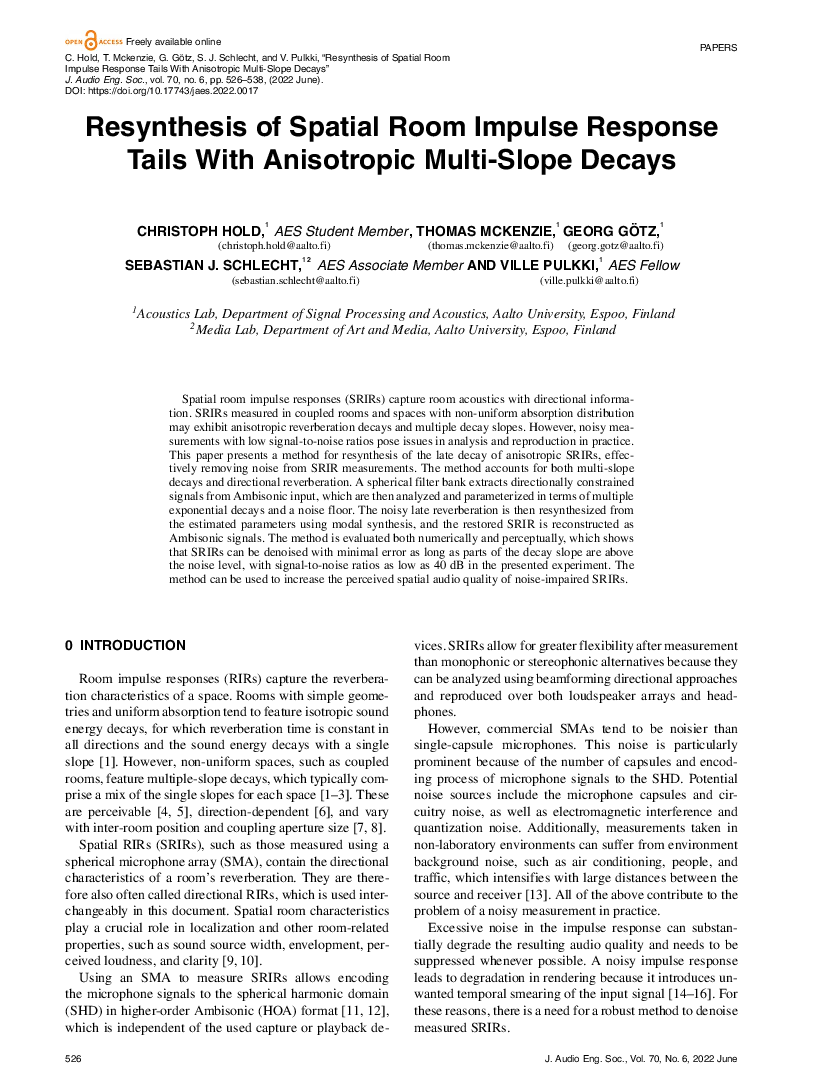Home / Publications / E-library page
You are currently logged in as an
Institutional Subscriber.
If you would like to logout,
please click on the button below.
Home / Publications / E-library page
Only AES members and Institutional Journal Subscribers can download
Spatial room impulse responses (SRIRs) capture room acoustics with directional information. SRIRs measured in coupled rooms and spaces with non-uniform absorption distribution may exhibit anisotropic reverberation decays and multiple decay slopes. However, noisy measurements with low signal-to-noise ratios pose issues in analysis and reproduction in practice. This paper presents a method for resynthesis of the late decay of anisotropic SRIRs, effectively removing noise from SRIR measurements. The method accounts for both multi-slope decays and directional reverberation. A spherical filter bank extracts directionally constrained signals from Ambisonic input, which are then analyzed and parameterized in terms of multiple exponential decays and a noise floor. The noisy late reverberation is then resynthesized from the estimated parameters using modal synthesis, and the restored SRIR is reconstructed as Ambisonic signals. The method is evaluated both numerically and perceptually, which shows that SRIRs can be denoised with minimal error as long as parts of the decay slope are above the noise level, with signal-to-noise ratios as low as 40 dB in the presented experiment. The method can be used to increase the perceived spatial audio quality of noise-impaired SRIRs.
Author (s): Hold, Christoph; Mckenzie, Thomas; Götz, Georg; Schlecht, Sebastian J.; Pulkki, Ville
Affiliation:
Acoustics Lab, Department of Signal Processing and Acoustics, Aalto University, Espoo, Finland; Acoustics Lab, Department of Signal Processing and Acoustics, Aalto University, Espoo, Finland; Acoustics Lab, Department of Signal Processing and Acoustics, Aalto University, Espoo, Finland; Acoustics Lab, Department of Signal Processing and Acoustics, Aalto University, Espoo, Finland; Media Lab, Department of Art and Media, Aalto University, Espoo, Finland; Acoustics Lab, Department of Signal Processing and Acoustics, Aalto University, Espoo, Finland
(See document for exact affiliation information.)
Publication Date:
2022-06-06
Import into BibTeX
Permalink: https://aes2.org/publications/elibrary-page/?id=21800
(895KB)
Click to purchase paper as a non-member or login as an AES member. If your company or school subscribes to the E-Library then switch to the institutional version. If you are not an AES member Join the AES. If you need to check your member status, login to the Member Portal.

Hold, Christoph; Mckenzie, Thomas; Götz, Georg; Schlecht, Sebastian J.; Pulkki, Ville; 2022; Resynthesis of Spatial Room Impulse Response Tails With Anisotropic Multi-Slope Decays [PDF]; Acoustics Lab, Department of Signal Processing and Acoustics, Aalto University, Espoo, Finland; Acoustics Lab, Department of Signal Processing and Acoustics, Aalto University, Espoo, Finland; Acoustics Lab, Department of Signal Processing and Acoustics, Aalto University, Espoo, Finland; Acoustics Lab, Department of Signal Processing and Acoustics, Aalto University, Espoo, Finland; Media Lab, Department of Art and Media, Aalto University, Espoo, Finland; Acoustics Lab, Department of Signal Processing and Acoustics, Aalto University, Espoo, Finland; Paper ; Available from: https://aes2.org/publications/elibrary-page/?id=21800
Hold, Christoph; Mckenzie, Thomas; Götz, Georg; Schlecht, Sebastian J.; Pulkki, Ville; Resynthesis of Spatial Room Impulse Response Tails With Anisotropic Multi-Slope Decays [PDF]; Acoustics Lab, Department of Signal Processing and Acoustics, Aalto University, Espoo, Finland; Acoustics Lab, Department of Signal Processing and Acoustics, Aalto University, Espoo, Finland; Acoustics Lab, Department of Signal Processing and Acoustics, Aalto University, Espoo, Finland; Acoustics Lab, Department of Signal Processing and Acoustics, Aalto University, Espoo, Finland; Media Lab, Department of Art and Media, Aalto University, Espoo, Finland; Acoustics Lab, Department of Signal Processing and Acoustics, Aalto University, Espoo, Finland; Paper ; 2022 Available: https://aes2.org/publications/elibrary-page/?id=21800
@article{hold2022resynthesis,
author={hold christoph and mckenzie thomas and götz georg and schlecht sebastian j. and pulkki ville},
journal={journal of the audio engineering society},
title={resynthesis of spatial room impulse response tails with anisotropic multi-slope decays},
year={2022},
volume={70},
issue={6},
pages={526-538},
month={june},}
TY – paper
TI – Resynthesis of Spatial Room Impulse Response Tails With Anisotropic Multi-Slope Decays
SP – 526 EP – 538
AU – Hold, Christoph
AU – Mckenzie, Thomas
AU – Götz, Georg
AU – Schlecht, Sebastian J.
AU – Pulkki, Ville
PY – 2022
JO – Journal of the Audio Engineering Society
VO – 70
IS – 6
Y1 – June 2022